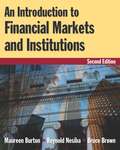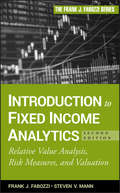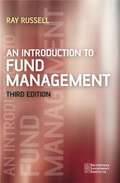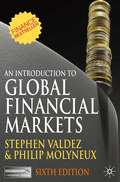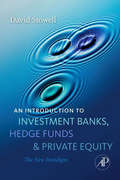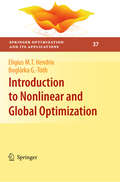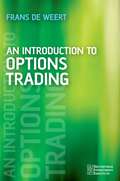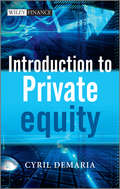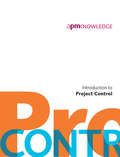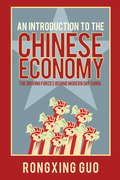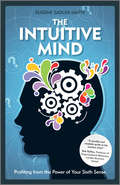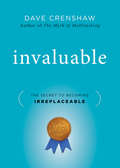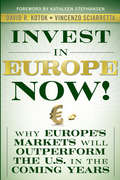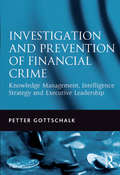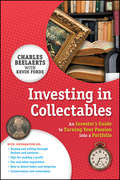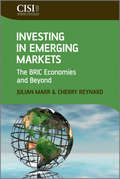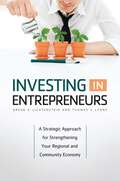- Table View
- List View
An Introduction to Financial Markets and Institutions
by Maureen Burton Reynold F. Nesiba Bruce BrownCompletely revised and updated to include the ongoing financial crisis and the Obama administration's programs to combat it, this is the best available introductory textbook for an undergraduate course on Financial Markets and Institutions. It provides balanced coverage of theories, policies, and institutions in a conversational style that avoids complex models and mathematics, making it a student-friendly text with many unique teaching features. Financial crises, global competition, deregulation, technological innovation, and growing government oversight have significantly changed financial markets and institutions. The new edition of this text is designed to capture the ongoing changes, and to present an analytical framework that enables students to understand and anticipate changes in the financial system and accompanying changes in markets and institutions. The text includes Learning Objectives and end-of-chapter Key Words and Questions, and an online Instructor's Manual is available to adopters.
Introduction to Fixed Income Analytics: Relative Value Analysis, Risk Measures and Valuation (Frank J. Fabozzi Ser. #83)
by Frank J. Fabozzi Steven V. MannA comprehensive introduction to the key concepts of fixed income analytics The First Edition of Introduction to Fixed Income Analytics skillfully covered the fundamentals of this discipline and was the first book to feature Bloomberg screens in examples and illustrations. Since publication over eight years ago, the markets have experienced cathartic change. That's why authors Frank Fabozzi and Steven Mann have returned with a fully updated Second Edition. This reliable resource reflects current economic conditions, and offers additional chapters on relative value analysis, value-at-risk measures and information on instruments like TIPS (treasury inflation protected securities). Offers insights into value-at-risk, relative value measures, convertible bond analysis, and much more Includes updated charts and descriptions using Bloomberg screens Covers important analytical concepts used by portfolio managers Understanding fixed-income analytics is essential in today's dynamic financial environment. The Second Edition of Introduction to Fixed Income Analytics will help you build a solid foundation in this field.
Introduction to Fixed Income Analytics: Relative Value Analysis, Risk Measures and Valuation
by Frank J. Fabozzi Steven V. MannA comprehensive introduction to the key concepts of fixed income analytics The First Edition of Introduction to Fixed Income Analytics skillfully covered the fundamentals of this discipline and was the first book to feature Bloomberg screens in examples and illustrations. Since publication over eight years ago, the markets have experienced cathartic change. That's why authors Frank Fabozzi and Steven Mann have returned with a fully updated Second Edition. This reliable resource reflects current economic conditions, and offers additional chapters on relative value analysis, value-at-risk measures and information on instruments like TIPS (treasury inflation protected securities). Offers insights into value-at-risk, relative value measures, convertible bond analysis, and much more Includes updated charts and descriptions using Bloomberg screens Covers important analytical concepts used by portfolio managers Understanding fixed-income analytics is essential in today's dynamic financial environment. The Second Edition of Introduction to Fixed Income Analytics will help you build a solid foundation in this field.
An Introduction to Fund Management (Securities Institute #23)
by Ray RussellAn Introduction to Fund Management introduces readers to the economic rationale for the existence of funds, the different types available, investment strategies and many other related issues from the perspective of the investment manager. It gives an overview of the whole business and explores the process and techniques of fund management, performance measurement and fund administration. This updated edition reflects new regulatory changes and industry developments.
An Introduction to Global Financial Markets
by Stephen Valdez N. Genetay Philip MolyneuxAn Introduction to Global Financial Markets describes the financial world in clear, easy to understand terms. The authors provide comprehensive coverage of commercial and investment banking, foreign exchange, money and bond markets, stock markets and derivatives and an up to date analysis of the global financial crisis. Key benefits:• A new chapter on the global financial crisis and banking regulation• Updated coverage of investment banking, hedge funds and private equity• Details of controversial new market instruments: credit default stops and collateralised mortgage obligations• Expanded coverage of emerging markets, including Brazil, Russia, India and China• New companion website featuring PPT slides, interactive revision questions, case studies and exercises, bonus chapters and analytical contentAn Introduction to Global Financial Markets is recommended for students studying finance and financial institutions, practitioners, and those who require an understanding of the global financial system.
An Introduction to Investment Banks, Hedge Funds, and Private Equity
by David StowellThe dynamic environment of investment banks, hedge funds, and private equity firms comes to life in David Stowell’s introduction to the ways they challenge and sustain each other. Capturing their reshaped business plans in the wake of the 2007-2009 global meltdown, his book reveals their key functions, compensation systems, unique roles in wealth creation and risk management, and epic battles for investor funds and corporate influence. Its combination of perspectives—drawn from his industry and academic backgrounds—delivers insights that illuminate the post-2009 reinvention and acclimation processes. Through a broad view of the ways these financial institutions affect corporations, governments, and individuals, Professor Stowell shows us how and why they will continue to project their power and influence.Emphasizes the needs for capital, sources of capital, and the process of getting capital to those who need it Integrates into the chapters 10 cases about recent transactions, along with case notes and questionsAccompanies cases with spreadsheets for readers to create their own analytical frameworks and consider choices and opportunities
Introduction to Nonlinear and Global Optimization (Springer Optimization and Its Applications #37)
by Eligius M.T. Hendrix Boglárka G.-TóthThis self-contained text provides a solid introduction to global and nonlinear optimization, providing students of mathematics and interdisciplinary sciences with a strong foundation in applied optimization techniques. The book offers a unique hands-on and critical approach to applied optimization which includes the presentation of numerous algorithms, examples, and illustrations, designed to improve the reader’s intuition and develop the analytical skills needed to identify optimization problems, classify the structure of a model, and determine whether a solution fulfills optimality conditions.
An Introduction to Options Trading (Securities Institute #26)
by Frans de WeertExplaining the theory and practice of options from scratch, this book focuses on the practical side of options trading, and deals with hedging of options and how options traders earn money by doing so. Common terms in option theory are explained and readers are shown how they relate to profit. The book gives the necessary tools to deal with options in practice and it includes mathematical formulae to lift explanations from a superficial level. Throughout the book real-life examples will illustrate why investors use option structures to satisfy their needs.
Introduction to Private Equity: Venture, Growth, Lbo And Turn-around Capital (The Wiley Finance Series #506)
by Cyril DemariaIntroduction to Private Equity is a critical yet grounded guide to the private equity industry. Far more than just another introductory guide, the book blends academic rigour with practical experience to provide a critical perspective of the industry from a professional who has worked at many levels within the industry, including insurance, funds of funds, funds and portfolio companies. The book looks at private equity from the point of view of the individual or the business. How is a private business valued? How is the acquisition transaction processed? What are the due diligence issues that should be considered before moving ahead? A valuable insight to a rather opaque market. Introduction to Private Equity covers the private equity industry as a whole, highlighting its historical development in order to put its recent development into perspective. The book covers its organization, governance and function, then details the various segments within the industry, including LBO, Venture Capital, Mezzanine Financing, Growth Capital and beyond. Finally, it offers a framework to anticipate and understand its future developments. It provides a balanced perspective on the current corporate governance challenges which are affecting the industry and draws perspective to understand the evolution of the sector, following one of its major crises.
Introduction to Private Equity (The Wiley Finance Series #560)
by Cyril DemariaIntroduction to Private Equity is a critical yet grounded guide to the private equity industry. Far more than just another introductory guide, the book blends academic rigour with practical experience to provide a critical perspective of the industry from a professional who has worked at many levels within the industry, including insurance, funds of funds, funds and portfolio companies. The book looks at private equity from the point of view of the individual or the business. How is a private business valued? How is the acquisition transaction processed? What are the due diligence issues that should be considered before moving ahead? A valuable insight to a rather opaque market. Introduction to Private Equity covers the private equity industry as a whole, highlighting its historical development in order to put its recent development into perspective. The book covers its organization, governance and function, then details the various segments within the industry, including LBO, Venture Capital, Mezzanine Financing, Growth Capital and beyond. Finally, it offers a framework to anticipate and understand its future developments. It provides a balanced perspective on the current corporate governance challenges which are affecting the industry and draws perspective to understand the evolution of the sector, following one of its major crises.
Introduction to Project Control
by APM Planning Specific Interest GroupThere is a narrow view of control which is about delivering projects in accordance with their plans, using disciplines like earned value and risk management already championed by APM. Introduction to Project Control, written by the APM Planning Specific Interest Group, offers a wider perspective, which includes doing the right projects. It involves integrating all the disciplines of project management and brings together material from the APM Body of Knowledge and other APM publications. Readers of this publication may also be interested in Planning, Scheduling, Monitoring and Control, Introduction to Project Planning and Project Risk Analysis and Management Guide.
An Introduction to the Chinese Economy: The Driving Forces Behind Modern Day China
by Rongxing GuoThis comprehensive overview of the modern Chinese economy by a noted expert from China offers a quality and breadth of coverage. In this book, the author provides an introduction to China's economy since 1949 and original insights based on his own extensive research. The book sets out to analyze and compare the operational mechanisms of the Chinese economy between the pre- and post-reform periods and through national, regional and local dimensions. Both positive and negative consequences of the Chinese economic transformation have been clarified. A multiregional comparison of the Chinese economy is conducted in terms of natural and human resources, institutional evolution, as well as economic and social performances. At last, some key issues relating to the inherent operational mechanisms of and the dynamic patterns of the Chinese economy are also discussed.
An Introduction to the Chinese Economy: The Driving Forces Behind Modern Day China
by Rongxing GuoThis comprehensive overview of the modern Chinese economy by a noted expert from China offers a quality and breadth of coverage. In this book, the author provides an introduction to China's economy since 1949 and original insights based on his own extensive research. The book sets out to analyze and compare the operational mechanisms of the Chinese economy between the pre- and post-reform periods and through national, regional and local dimensions. Both positive and negative consequences of the Chinese economic transformation have been clarified. A multiregional comparison of the Chinese economy is conducted in terms of natural and human resources, institutional evolution, as well as economic and social performances. At last, some key issues relating to the inherent operational mechanisms of and the dynamic patterns of the Chinese economy are also discussed.
The Intuitive Mind: Profiting from the Power of Your Sixth Sense
by Eugene Sadler-SmithThis new agenda for the managerial mind will change the way you think and do business. Eugene Sadler-Smith, a leading intuition researcher and educator in business and management, argues that human beings have one brain but two minds – analytical and intuitive. Management has overlooked the importance of intuition, and under-exploited the potential that the intuitive mind has to contribute in areas as diverse as decision making, creativity, team working, entrepreneurship, business ethics and leadership. “The Intuitive Mind is a fascinating and practical book that will maximize your intuition and help you make better decisions today and predictions about tomorrow! Sigmund Freud and Carl Jung would most assuredly approve.” Steve W. Martin, www.heavyhitterwisdom.com Heavy Hitter Sales Psychology: How to Penetrate the C-Level Executive Suite and Convince Company Leaders to Buy “Eugene Sadler-Smith gives needed attention to the intuitive way of thinking and reminds us that leadership is an art as well as a science.” Cindi Fukami, Professor of Management, University of Denver, USA “From one of our prominent ‘thinkers’ in the management education arena, we learn in The Intuitive Mind how to use our intuitive judgment to improve our managerial decision making.” Joe Raelin, The Knowles Chair for Practice-Oriented Education, Northeastern University, USA “This timely, well researched and accessible book takes intuition out of the shadows and provides practical guidance to solve thorny problems.” Sebastian Bailey, Global Product Director, The Mind Gym
Invaluable: The Secret to Becoming Irreplaceable
by Dave CrenshawA business fable for anyone feeling overwhelmed, underpaid, and frustrated in their job From the author of The Myth of Multitasking comes Invaluable, a business fable that empowers the frustrated and overworked to understand the value of their time. At the fictitious company GreenGarb, twenty-something Jason is discontent in his entry-level position, feeling his skills and knowledge are being underutilized; mid-level manager Tracy is overwhelmed by her own workload and needy direct reports; and CEO Helen needs them to sort it out productively. Jason's grandfather Charlie plants the seed of a new perspective in Jason mind: before he can get a raise, he must prove he deserves the raise. He must establish the value of his time, rather than expecting to be paid what he thinks he is worth. Time management consultant Phil helps them determine how they spend their time, and what it costs, with easy-to-follow worksheets that map what their actions and time are worth. Offers solid advice for determining just how "invaluable" you are to your boss and customers Shows how to create a productive framework of cooperation in the workplace Includes an appendix of worksheets and examples that offer concrete tools that can be applied immediately The Myth of Multitasking taught readers how to take control of their time. Invaluable shows readers how to increase the value of the time they do spend working.
Invaluable: The Secret to Becoming Irreplaceable
by Dave CrenshawA business fable for anyone feeling overwhelmed, underpaid, and frustrated in their job From the author of The Myth of Multitasking comes Invaluable, a business fable that empowers the frustrated and overworked to understand the value of their time. At the fictitious company GreenGarb, twenty-something Jason is discontent in his entry-level position, feeling his skills and knowledge are being underutilized; mid-level manager Tracy is overwhelmed by her own workload and needy direct reports; and CEO Helen needs them to sort it out productively. Jason's grandfather Charlie plants the seed of a new perspective in Jason mind: before he can get a raise, he must prove he deserves the raise. He must establish the value of his time, rather than expecting to be paid what he thinks he is worth. Time management consultant Phil helps them determine how they spend their time, and what it costs, with easy-to-follow worksheets that map what their actions and time are worth. Offers solid advice for determining just how "invaluable" you are to your boss and customers Shows how to create a productive framework of cooperation in the workplace Includes an appendix of worksheets and examples that offer concrete tools that can be applied immediately The Myth of Multitasking taught readers how to take control of their time. Invaluable shows readers how to increase the value of the time they do spend working.
Invest in Europe Now!: Why Europe's Markets Will Outperform the US in the Coming Years
by David R. Kotok Vincenzo SciarrettaAn insider's guide to investing in Europe With the U.S. market in shambles, investors are looking for other places to put their money. Europe has become the destination of choice, and will continue to be for the foreseeable future. Using the different perspectives of an author who lives in Europe and an author who lives in the United States, Invest in Europe Now! is one the most informative guides to making money outside North America. It outlines the best ways to take advantage of the rapidly shifting global financial environment and shows you what indicators to follow, what instruments and markets are best poised for growth, and how to avoid various pitfalls along the way. Outlines the safest ways to invest in Europe and secure the returns you desire Written by a unique author team, which represent both the U.S. and European perspective Discusses how some European markets and stocks are relatively more attractive than their American counterparts Throughout this book, David Kotok and Vincenzo Sciaretta reveal the realities of investing in Europe and how you can benefit from doing so.
Invest in Europe Now!: Why Europe's Markets Will Outperform the US in the Coming Years
by David R. Kotok Vincenzo SciarrettaAn insider's guide to investing in Europe With the U.S. market in shambles, investors are looking for other places to put their money. Europe has become the destination of choice, and will continue to be for the foreseeable future. Using the different perspectives of an author who lives in Europe and an author who lives in the United States, Invest in Europe Now! is one the most informative guides to making money outside North America. It outlines the best ways to take advantage of the rapidly shifting global financial environment and shows you what indicators to follow, what instruments and markets are best poised for growth, and how to avoid various pitfalls along the way. Outlines the safest ways to invest in Europe and secure the returns you desire Written by a unique author team, which represent both the U.S. and European perspective Discusses how some European markets and stocks are relatively more attractive than their American counterparts Throughout this book, David Kotok and Vincenzo Sciaretta reveal the realities of investing in Europe and how you can benefit from doing so.
Investigation and Prevention of Financial Crime: Knowledge Management, Intelligence Strategy and Executive Leadership
by Petter GottschalkSo long as there are weaknesses that can be exploited for gain, companies, other organizations and private individuals will be taken advantage of. This theoretically-based but hugely practical book focuses on what is generally seen as financial or economic crime: theft, fraud, manipulation, and corruption. Petter Gottschalk considers how, in some competitive environments, goals can 'legitimise' all kinds of means, and how culture can exert a role in relation to what is seen as acceptable or unacceptable behaviour by individuals. In Investigation and Prevention of Financial Crime he addresses important topics including organized crime, money laundering, cyber crime, corruption in law enforcement agencies, and whistleblowing, and provides expert advice about strategies for the use of intelligence to combat financial crime. The uniqueness of his approach to the subject lies in the way he is able to explain intelligence and intelligence processes in the wider context of knowledge and knowledge management. The numerous case studies throughout the book illustrate the 'policing' of financial crime from an intelligence, knowledge management and systems perspective. Law enforcers, lawyers, security personnel, consultants and investigators, as well as those in auditing and accountancy and with responsibilities for containing risk in banks, other financial institutions and in businesses generally, will find this an invaluable source of practical guidance. The book will also be of interest to advanced students and researchers in criminology and police science.
Investigation and Prevention of Financial Crime: Knowledge Management, Intelligence Strategy and Executive Leadership
by Petter GottschalkSo long as there are weaknesses that can be exploited for gain, companies, other organizations and private individuals will be taken advantage of. This theoretically-based but hugely practical book focuses on what is generally seen as financial or economic crime: theft, fraud, manipulation, and corruption. Petter Gottschalk considers how, in some competitive environments, goals can 'legitimise' all kinds of means, and how culture can exert a role in relation to what is seen as acceptable or unacceptable behaviour by individuals. In Investigation and Prevention of Financial Crime he addresses important topics including organized crime, money laundering, cyber crime, corruption in law enforcement agencies, and whistleblowing, and provides expert advice about strategies for the use of intelligence to combat financial crime. The uniqueness of his approach to the subject lies in the way he is able to explain intelligence and intelligence processes in the wider context of knowledge and knowledge management. The numerous case studies throughout the book illustrate the 'policing' of financial crime from an intelligence, knowledge management and systems perspective. Law enforcers, lawyers, security personnel, consultants and investigators, as well as those in auditing and accountancy and with responsibilities for containing risk in banks, other financial institutions and in businesses generally, will find this an invaluable source of practical guidance. The book will also be of interest to advanced students and researchers in criminology and police science.
Investing in Collectables: An Investor's Guide to Turning Your Passion Into a Portfolio
by Charles BeelaertsEver wanted to make money from investing in something you love? Whether you're looking to make money from your hobby or collection, or you're a serious investor seeking to profit from your passion or diversify your portfolio, Investing in Collectibles contain all you need to know. Inside you'll discover: tips for making a profit on your collection how to buy and sell through art dealers and private sale, and at auctions tax and other legislation governing collectibles as an investment how to invest through self managed superannuation funds or trusts how to detect fakes and forgeries. This is the ultimate guide to collecting, investing in and making money from collectables.
Investing in Collectables: An Investor's Guide to Turning Your Passion Into a Portfolio
by Charles BeelaertsEver wanted to make money from investing in something you love? Whether you're looking to make money from your hobby or collection, or you're a serious investor seeking to profit from your passion or diversify your portfolio, Investing in Collectibles contain all you need to know. Inside you'll discover: tips for making a profit on your collection how to buy and sell through art dealers and private sale, and at auctions tax and other legislation governing collectibles as an investment how to invest through self managed superannuation funds or trusts how to detect fakes and forgeries. This is the ultimate guide to collecting, investing in and making money from collectables.
Investing in Emerging Markets: The BRIC Economies and Beyond (Securities Institute Ser. #17)
by Julian Marr Cherry ReynardFor more than a decade, emerging markets have proved one of the most exciting areas of investment, but the sector has not been without its dangers. Private and professional investors alike have continuously been attracted by the promise of riches on offer from countries such as China, India, Brazil and Russia but, as often as not, have been left with their fingers burnt. Investing in Emerging Markets: The BRIC Economies and Beyond tempers the undoubted causes for emerging market optimism with a healthy dose of reality, illustrating how for every argument in favour of investing in the sector there are one or more reasons to tread very carefully indeed. In the wake of the credit crunch and ensuing market turmoil, it also analyses where the emerging markets now fit within the global investment landscape. With the economies of the US, Europe and Japan hit by an economic crisis very much of their own making, has the credibility gap between developed and developing markets narrowed? Has the playing field become more level? Investing in Emerging Markets: The BRIC Economies and Beyond offers a fresh, clear-eyed and objective look at an area that can only grow in importance over the next decade. It balances a realistic appraisal of the opportunities on offer from the emerging markets with a pragmatic assessment of the potential pitfalls facing investors, in the process providing an accessible introduction to newcomers and more experienced investors with a valuable and compact point of reference.
Investing in Emerging Markets: The BRIC Economies and Beyond (Securities Institute #17)
by Julian Marr Cherry ReynardFor more than a decade, emerging markets have proved one of the most exciting areas of investment, but the sector has not been without its dangers. Private and professional investors alike have continuously been attracted by the promise of riches on offer from countries such as China, India, Brazil and Russia but, as often as not, have been left with their fingers burnt. Investing in Emerging Markets: The BRIC Economies and Beyond tempers the undoubted causes for emerging market optimism with a healthy dose of reality, illustrating how for every argument in favour of investing in the sector there are one or more reasons to tread very carefully indeed. In the wake of the credit crunch and ensuing market turmoil, it also analyses where the emerging markets now fit within the global investment landscape. With the economies of the US, Europe and Japan hit by an economic crisis very much of their own making, has the credibility gap between developed and developing markets narrowed? Has the playing field become more level? Investing in Emerging Markets: The BRIC Economies and Beyond offers a fresh, clear-eyed and objective look at an area that can only grow in importance over the next decade. It balances a realistic appraisal of the opportunities on offer from the emerging markets with a pragmatic assessment of the potential pitfalls facing investors, in the process providing an accessible introduction to newcomers and more experienced investors with a valuable and compact point of reference.
Investing in Entrepreneurs: A Strategic Approach for Strengthening Your Regional and Community Economy
by Gregg A. Lichtenstein Thomas S. LyonsA compelling argument for placing entrepreneurship at the heart of economic development provides a guidebook for how this can be done efficiently, effectively, and equitably.Investing in Entrepreneurs: A Strategic Approach for Strengthening Your Regional and Community Economy offers a compelling argument for making the support of entrepreneurship the centerpiece of local and regional economic development—and provides a plan to make it happen. The book is organized around a tool, developed by the authors, that permits a community to strategically map and manage its business assets in a way that can transform its economy. Investing in Entrepreneurs begins with a reflection on the importance of entrepreneurship, a discussion of its diminished place in economic development, and a call for its rise back to prominence. The importance of managing entrepreneurial assets is discussed, followed by a thorough articulation of the author's tool for accomplishing this in a holistic and strategic manner. Examples drawn from the authors' fieldwork illustrate the many ways in which the tool can be utilized to guide economic development efforts. A final chapter discusses possible resistance to this innovation and how that resistance can be successfully addressed.
